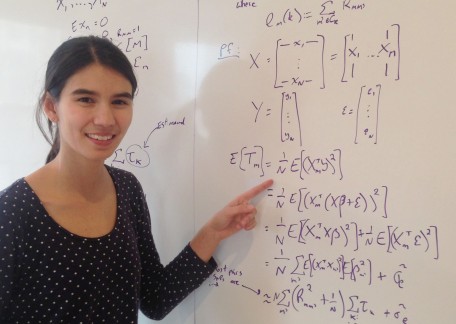
Creative Minds: Building Better Computational Models of Common Disease

Hilary Finucane
Not so long ago, Hilary Finucane was a talented young mathematician about to complete a master’s degree in theoretical computer science. As much as she enjoyed exploring pure mathematics, Finucane had begun having second thoughts about her career choice. She wanted to use her gift for numbers in a way that would have more real-world impact.
The solution to her dilemma was, literally, standing right by her side. Her husband Yakir Reshef, also a mathematician, was developing a new algorithm at the Broad Institute of MIT and Harvard, Cambridge, MA, to improve detection of unexpected associations in large data sets. So, Finucane helped the Broad team with modeling biomedical topics ranging from the gut microbiome to global health. That work led to her co-authoring a paper in the journal Science [1], providing a strong start to what’s shaping up to be a rewarding career in computational biology.
Now one of Broad’s Schmidt Science Fellows, Finucane recently received an NIH Director’s 2017 Early Independence Award to apply her mathematical skills to a major challenge in biomedical research: developing more powerful computational tools to help researchers zero in on cell types relevant to a particular disease [2-3]. Just as accusing an innocent person of a crime doesn’t lead to the truth, researchers gain nothing from interrogating a cell for answers to a disease in which it plays no role. Right now, it can be tough to sift through the vast troves of information in various biomedical databases to make that call.
For example, the Encyclopedia of DNA Elements (ENCODE) Consortium is a fantastic online listing of functional elements that regulate gene expression. But it isn’t set up to explore the mechanisms of complex human diseases, such as cancer. The opposite is true for genome-wide association studies (GWAS), which identify genetic variants associated with disease risk but often provide limited insights into a disease’s underlying biology. Finucane will develop computational models that allow researchers to integrate ENCODE data and other fundamental biological information with GWAS data, paving the way for a broader, more telling picture of human health and disease.
Finucane’s starting point will be the more than 2,500 GWAS studies published to date, which have linked nearly 25,000 unique gene variants to disease traits [4]. Many of these studies have focused on finding fairly common genetic variants that have a very modest impact on disease risk. Finucane wants to flip the script. She will develop computational methods to analyze, in aggregate, the potentially more significant effects of thousands of relatively common genetic variants.
As part of this work, Finucane will look for regions of the genome that are active in a tissue or cell type. She will then test whether these regions are enriched for disease-related GWAS variations. The hope is that this bioinformatics work will give researchers all around the world a new tool for exploring the molecular mechanisms of disease, paving the way for more precise strategies for disease prevention, treatment, and cure.
References:
[1] Detecting novel associations in large data sets. Reshef DN, Reshef YA, Finucane HK, Grossman SR, McVean G, Turnbaugh PJ, Lander ES, Mitzenmacher M, Sabeti PC. Science. 2011 Dec 16;334(6062):1518-1524.
[2] Partitioning heritability by functional annotation using genome-wide association summary statistics. Finucane HK, Bulik-Sullivan B, Gusev A, Trynka G, Reshef Y, Loh PR, Anttila V, Xu H, Zang C, Farh K, Ripke S, Day FR; ReproGen Consortium; Schizophrenia Working Group of the Psychiatric Genomics Consortium; RACI Consortium, Purcell S, Stahl E, Lindstrom S, Perry JR, Okada Y, Raychaudhuri S, Daly MJ, Patterson N, Neale BM, Price AL. Nat Genet. 2015 Nov;47(11):1228-1235.
[3] An atlas of genetic correlations across human diseases and traits. Bulik-Sullivan B, Finucane HK, Anttila V, Gusev A, Day FR, Loh PR; ReproGen Consortium; Psychiatric Genomics Consortium; Genetic Consortium for Anorexia Nervosa of the Wellcome Trust Case Control Consortium, Duncan L, Perry JR, Patterson N, Robinson EB, Daly MJ, Price AL, Neale BM. Nat Genet. 2015 Nov;47(11):1236-1241.
[4] The new NHGRI-EBI Catalog of published genome-wide association studies (GWAS Catalog). MacArthur J, Bowler E, Cerezo M, Gil L, Hall P, Hastings E, Junkins H, McMahon A, Milano A, Morales J, Pendlington ZM, Welter D, Burdett T, Hindorff L, Flicek P, Cunningham F, Parkinson H. Nucleic Acids Res. 2017 Jan 4;45(D1):D896-D901.
Links:
Finucane Lab (Broad Institute of MIT and Harvard, Cambridge, MA)
Finucane Project Information (NIH RePORTER)
NIH Director’s Early Independence Award (Common Fund)
NIH Support: Common Fund






















.png)











No hay comentarios:
Publicar un comentario